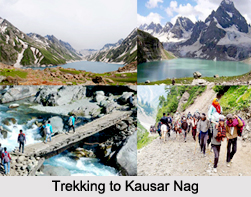 Kausar Nag or Kausarnag is a high-altitude oligotrophic lake located in the Pir Panjal Range in the Kulgam District of the Indian state of Jammu and Kashmir. Kausarnag has the religious significance to the Kashmiri pandit, who is the original inhabitants in Jammu and Kashmir region. Kulgam District is the epicentre of the religious minded people, those who are the Hindu and became the head of the state during the rule of Hindu Rajas of Jammu and Kashmir.
Kausar Nag or Kausarnag is a high-altitude oligotrophic lake located in the Pir Panjal Range in the Kulgam District of the Indian state of Jammu and Kashmir. Kausarnag has the religious significance to the Kashmiri pandit, who is the original inhabitants in Jammu and Kashmir region. Kulgam District is the epicentre of the religious minded people, those who are the Hindu and became the head of the state during the rule of Hindu Rajas of Jammu and Kashmir.
Location of Kausarnag
Kausarnag is roughly 2 miles long and half a mile at the widest point. The trek to Kausarnag is via the famous waterfall of Aharbal.
Geography of Kausarnag
Kausarnag is located in a valley that is surrounded by peaks on all sides with elevation in excess of 4000 metres above sea level.
History of Kausarnag
According to Panun Kashmir, Kausarnag is one of the two places in Kashmir Valley that is associated with worship of "Visnupad". The other shrine of "Visupad" is located in the foothills of Pir Panjal at Fatehpur, in Dooru-Shahbad tehsil, not much away from Verinag (Nilkunda) Spring. Fatehpur shrine houses as per local folklore, footprints of Lord Vishnu on a stone.
Kausarnag and Kashmiri Pandits in Modern India
In July 2014, a controversy erupted when a group of Kashmiri pandits asked the state government to allow them to proceed for an annual yatra to the lake from the valley side. Pertinently, for the past five years, a yatra was being conducted from Reasi side to the place but managed by the local administration. However, the experts have warned against such moves saying the ecological set up would be disturbed. Moreover, experts and the majority political players are of the opinion that the glacial water bodies are only tourist spots and do not have any religious significance. This led to protests in the Jammu and Kashmir Valley, especially in the Kulgam district against the conduct of the yatra. Although, the regular excursions to Kausarnag by local schools are common and tourists are allowed to visit the lake from both national and international origin. The protests were only against pilgrimage by Kashmiri Pandits.
Related Articles
Culture of Jammu and Kashmir
Jammu and Kashmir, Indian State
Pir Panjal Range
Kashmir Himalaya



















